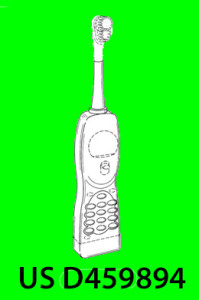A visitor from another planet might wonder why the toothbrush depicted here looks like a telephone. Those of us on planet earth already know the answer—the toothbrush looks like a telephone because it can! In today’s world a cup holder can resemble a skull and a telephone can appear like a banana.
These, and more sophisticated industrial designs, add great value and distinguish products. They are so valuable that the U.S. has established a unique patent system for protecting designs.
Because of the expenses — over $750 in filing fees, $200 to $1,000 plus for drawings (unless you do it yourself), and $500 to several thousand dollars in lawyer fees (unless you file it yourself) — you should weigh the strengths and weaknesses of your design before proceeding with the process.
Patent law has established three requirements for issuing a design patent. The design must be:
- new and original, and
- an ornamental design for a useful article of manufacture,
In addition to these requirements, the filing must be done prior to any sale or publication of the design (with limited exceptions if the sale was under the direction of the designer and within one year of the filing). If the USPTO is unaware of violations of this rule and issues a design patent, the patent will be declared invalid if someone can later show that the design was publicly shown or sold.
Can you file by yourself? Preparing and filing a design patent is fairly simple—at least compared to preparing and filing a utility patent (for a useful invention, not a design). If you’re a self-starter with a do-it-yourself mindset, you can, with a bit of work, prepare your own design patent application and save hundreds (or thousands) of dollars. On the other hand, if you have uncertainties — for example, as to the value of a design patent, whether you’re a good candidate, or how to best present your design — an attorney’s help may be worth the money. In either case, we can help steer you on to the proper course.

